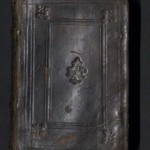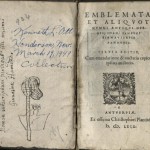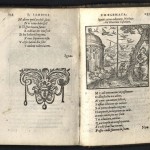Tags
Arnold Nicolai, Christopher Plantin, Cornelis Muller, emblem book, emblemata, engraving, Ferdinand I, Geoffroy Ballain, Gerard Janssen van Kampen, humanism, Hungarian, Janos Zsamboki, Kenneth Lawrence Ott, Lucas d'Heere, Maximilian II, Okanagan County Museum, Pieter Huys, Plantin, Plantini, Roman coins, Rudolf II, vignettes, wood engravings, woodcuts
- Zsamboki, Emblemata, 1569, Cover
- Zsamboki, Emblemata, 1569, Title Page
- Zsamboki, Emblemata, 1569
Emblemata et Aliqvot Nvmmi Antiqvi…
Janos Zsamboki (1531-1584)
Antverpiae: Ex officina Christophori Plantini, mdlxix [1569]
The emblem book addressed a wide range of interests within humanist culture, among them the purpose of poetry and the relative power of the visual and the verbal. The first edition of physician Janos Zsamboki’s Emblemata was printed by the Plantin press in 1564. It was the first new emblem book to appear outside of Italy or France and is one of the largest and most influential examples of the genre at an early state of its development. An expanded edition was published in 1566 and was reprinted four times.
Janos Zsamboky was a Hungarian humanist who spent much of his life in Vienna as court-historiographer to the Habsburg emperors Ferdinand I, Maximilian II, and Rudolf II. This edition opens with an emblem dedicated to the newly elected emperor Maximilian II. Zsamboky prepared his emblem book at the end of two decades of traveling throughout Germany, France, Italy, and the Low Countries, before he entered the court in Vienna. Other works from Zsamboki include editions of classical texts and historiographical works. His was renowned for his scholarly patronage and an impressive collection of books and old manuscripts.
Emblemata consists of single pages containing a motto, a woodcut illustration and an epigram. Nearly a third of the emblems are also accompanied by dedications to well-known humanists, powerful courtiers, clergymen and friends and relatives. Zsamboki commissioned Lucas d’Heere to draw the illustrations. Christopher Plantin had half of d’Heere’s designs redrawn by Geoffory Ballain and Pieter Huys. The woodcuts were produced by Gerard Janssen van Kampen, Cornelis Muller and Arnold Nicolai. The Plantin printer’s device appears on the title-page. A full-page engraving of Zsamboki faces the preface. Various decorative vignettes throughout. Several leaves with wood engravings of Roman coins at the end of the book.
From the Kenneth Lieurance Ott Collection donated to the Okanagan County Museum, Washington.





You must be logged in to post a comment.